Shopify Themes 101: All you need to know
Key Takeaways
- Shopify themes are tailored for optimal eCommerce design, offering a blend of aesthetics and functionality.
- With both free and premium options available, Shopify themes ensure mobile responsiveness for a seamless shopping experience.
What are Shopify Themes?
Shopify Themes are website templates you can choose for your Shopify Store, which are available on the Shopify Theme Store and other third-party web template marketplaces. They play an important role in determining how your website looks and feels for customers who visit it.
In technical terms, The Shopify Themes display what the users see on the screen through HTML, CSS, JS, Liquid, and picture files, which offers a different style, layout, and user experience.
Why Shopify Themes Matter?
Cost-effective
An average website costs $12,000 to $150,000 to develop from scratch (with an agency or freelancer), while Shopify themes help you design a beautiful store from 0$! Alternatively, premium themes are necessary if you want your website to have more features or to have a large product range. You will need to spend a few hundred dollars on them, but it’s still cheaper than building your own.
Helps Project Your Brand Personality
Convincing messages don’t usually come from just words, but a combination of brand imagery like:
- Logos
- Photography
- Illustration
- Iconography
- Typography
- Video
- Animation
- Colour palettes
- Composition rules
- Filters
- Backgrounds
- UI components
It is definitely overwhelming for anyone, including myself, to start a Shopify Store. You might have questions like what messages these colors are, what font type is saying about your products, and whether it should be that way, etc.
However, Shopify Themes helps you with a consistent set of brand imagery elements and pre-decide every design/aesthetic choice for you. All you have to do is choose the right one. To aid your decision, consider looking at top-performing stores in your niche or your competitors, checking what Shopify theme they are using and if a similar design could work for your store.
You might not know how to create ones, but you will know it when a Theme is on point for your store/products, just like any customers who visit your store!
Determines Your Website’s UX
You might not know how to do it, but the designer behind Shopify Themes knows how to make it a lot smoother for your customers. And it could directly improve your sales:
- When smartphone users can’t find the information they need or the site is too slow, 29% will switch to another website or app immediately.
- 69% of site visitors are more likely to buy from an online store if the mobile site or app makes it easy for them to find answers to their questions (for example, appropriately displaying product information).
That’s where Shopify Themes come to rescue you!
Crucial factors when choosing a Shopify theme
Selecting the right Shopify theme is pivotal for your eCommerce store, influencing its appearance, performance, and user experience. Given the plethora of available options, making a choice can seem daunting. Here’s a simplified guide to factors you should consider:
- Performance: Site speed impacts both user experience and SEO. A laggy site may deter visitors and negatively affect search engine rankings.
- Design: Ensure a design that’s both user-friendly and visually appealing. It should be mobile-responsive and compliant with current accessibility standards to attract and retain customers.
- Features: Your theme’s features will govern your store’s user experience. Pick a theme that aligns with your requirements. For instance, a vast product range demands efficient search, filtering options, and an expansive menu.
- Customization: Opt for a theme that offers diverse customization options, enabling you to tailor it according to your brand’s needs.
- Support: Having robust support for your theme is vital. Ensure access to comprehensive documentation and prompt assistance from the theme provider.
- Reviews: Glean insights from reviews. They shed light on the theme’s performance, support quality, and update frequency. Check reviews on the theme’s page or third-party sites like Heycarson.
- Price: Themes can range in price. Depending on your budget, you might go for a free theme or a premium one. Remember, additional costs may arise for extra apps or further customizations.
- Source: Ensure you’re purchasing from a reputable source. The Shopify Theme Store is a trusted place, offering vetted themes with no licensing hassles. However, be cautious on platforms like Themeforest, where some themes might not meet quality standards.
By focusing on these criteria, you can select a Shopify theme that aligns well with your business needs and provides an excellent user experience.
Related posts
Shopify Theme Price | Free vs. Paid option
Quick view
Shopify offers two primary theme categories: free and paid. Free themes, ideal for beginners, provide basic features and limited design flexibility. On the other hand, paid themes, priced between $140 to $200, offer enhanced features and customization options, allowing for a distinct store appearance. For those seeking advanced customization, some premium themes can even go up to $350. The choice between free and paid themes largely depends on your desired features and budget considerations.
When selecting a theme, it’s vital to align it with your store’s aesthetic and brand. Ensure it complements both your brand identity and the products you offer. With Shopify’s extensive range of themes, you’re bound to find the right fit. Whether you lean towards a free or paid option, Shopify caters to all preferences.
Key comparison
| Free themes | Paid themes | |
|---|---|---|
| Price |
|
|
| Design |
|
|
| Main Features |
|
|
| Performance |
|
|
| Support |
|
|
| Popular theme choices |
|
|
Who is for who?
Free Shopify theme
Free themes on Shopify are perfect for beginners working within a budget. They offer an easy way to set up a store, providing a foundation to swiftly:
- Grasp the essentials of Shopify.
- Identify the features your business might need.
A free theme can suffice if your eCommerce needs are straightforward and you have a limited product range. However, as your brand expands, you might:
- Need to integrate multiple paid apps to cater to your growing audience.
- Consider upgrading to a more advanced theme to meet evolving requirements.
Overall, here are the types of businesses that the Free Shopify Themes may be suitable for:
-
New Entrepreneurs: Free Shopify themes are especially beneficial for those new to the e-commerce landscape, offering an affordable start.
-
Small Businesses: Ideal for small businesses with a limited inventory and basic design requirements.
-
Budget-Conscious Users: Perfect for individuals looking to minimize upfront costs while exploring online retail.
-
Testers: Suitable for those wanting to test the waters before investing more significantly in their online presence.
Paid Shopify theme
Paid themes cater to both newcomers and seasoned business owners. They stand out because:
- They’re user-friendly, despite their myriad features and customization capabilities.
- Comprehensive support documentation and top-notch customer service accompany them.
For those aiming to elevate their store or manage extensive product collections, paid themes are a prime choice. Their advantages include:
- In-built features, eliminating the need for additional apps like countdown banners or product filters.
- A streamlined approach, preventing potential technical setbacks and added costs often seen with excessive app integrations. In essence, for businesses with substantial eCommerce needs, a paid theme is a worthy investment.
Overall, here are the types of businesses that the Paid Shopify Themes may be suitable for:
-
Established Retailers: Ideal for experienced retailers seeking advanced customization and features.
-
Growing Businesses: For businesses expanding their inventory and requiring enhanced functionalities.
-
Professional Brands: Suitable for brands looking to provide a seamless, professional online shopping experience.
-
Niche Markets: Tailored options available for specific industries and market needs.
Where can I get Shopify Theme?
Shopify Theme Store
What is Shopify Theme Store?
Shopify Theme Store is a marketplace where you can find Shopify Themes with different User Interfaces and integrated features for your Shopify Store.
You can always try applying both free and premium themes to your store. However, you will have to purchase these premium themes before publishing them.
How to use the Shopify Theme store
Search for themes
You can click in the search bar to start searching for:
- Themes for your product
- Themes for your store
- Themes for your industry
- Themes that have certain features you want
- Free and premium themes
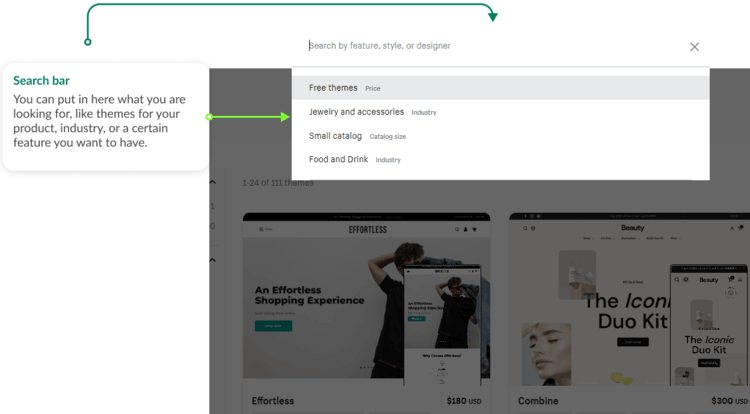
Theme Filters
On the other hand, you can also browse through the themes with Theme Filters. For choosing criteria, you will be able to preview the exact themes that match with it. You might want to look around the Premium themes in Home and Decor, for example.
Here are the filters you can choose from:
Price
- Free
- Premium
Industry
- Arts and crafts
- Baby and kids
- Books, music and video
- Business equipment and supplies
- Clothing
- Electronics
- Food and drink
- Hardware and automotive
- Health and beauty
- Home and decor
- Jewelry and accessories
- Outdoor and garden
- Pet supplies
- Restaurants
- Services
- Sports and recreation
- Toy and games
- Other
Catalog size
- 1-9 products
- 10-199 products
- 200+ products
Features
- Age verifier
- Back-to-top button
- Before/after image slider
- Breadcrumbs
- Color swatches
- Countdown timer
- EU translations (EN, FR, IT, DE, ES)
- Event Calendar
- In-menu promos
- Infinite scroll
- Mega menu
- Quick view
- Stock counter
- Store locator
- Sticky Header
Third-party marketplaces for Shopify Theme
Besides Shopify Theme Store, these are the top 3 third-party marketplaces to get Shopify Theme:
- EnvatoElements: EnvatoElements is a marketplace for professional digital assets, resources and services. Instead of one-time purchases, EnvatoElements offers you thousands of Shopify Themes for the start of $16.50 subscription per month

- Themeforest: Themeforest is a marketplace for website themes and templates as a part of the Envato Market. Themeforest Shopify Themes price varies from as low as $16 to 114$.
- TemplateMonster: TemplateMonster is a Website Templates, Plugins, and Graphics Digital Marketplace. Especially it provides you with a very helpful search function and a filter to find the most suitable theme for your store.
However, you will have to download them from these marketplaces and manually upload them to your Shopify Store. It might also come with some compatibility problems if the theme has been outdated.
How to install and edit Shopify Themes?
Visit your Shopify Theme Store
- Go to the Shopify Theme Store.
- At the top of the page, click Collections or Industries, and then select a category.
- To refine your search results, use the filters on the sidebar menu.
Or you can access the Shopify theme store inside the admin panel:
Choosing a theme for your website
In the Shopify Theme Store, you can click on a theme to see its info page
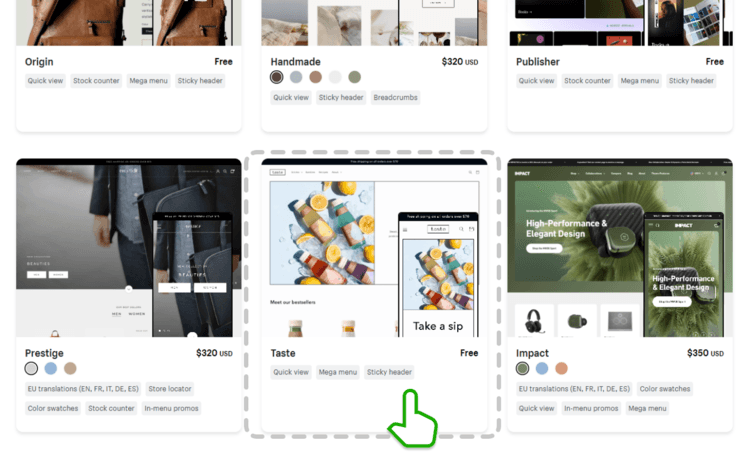
Click on “Try theme” to apply it to your Shopify store.

Customize your Shopify theme
In the Admin Panel, click on “Online Store” in the left menu, then click on Themes.
The themes you have chosen from the Shopify Theme Store will be inside the Theme Library (as drafts). These themes are only visible to you, and you can switch between themes by publishing them to your store.
Let’s start to Customize your Current Theme or Customize your added themes there.
The theme editor might seem complicated at first but don’t worry; I will walk you through the fundamental of it.
Shopify theme editor: Left Menu

The Left Menu will help you:
- Navigating between blocks
- Organizing the order of blocks: up and down, and left to right
- Adding new blocks and sections
- Deleting blocks
- Hiding blocks
Shopify theme editor: Right Menu
Inside a section, there are different blocks that you can edit, such as Image, Heading, Text, Button, etc.
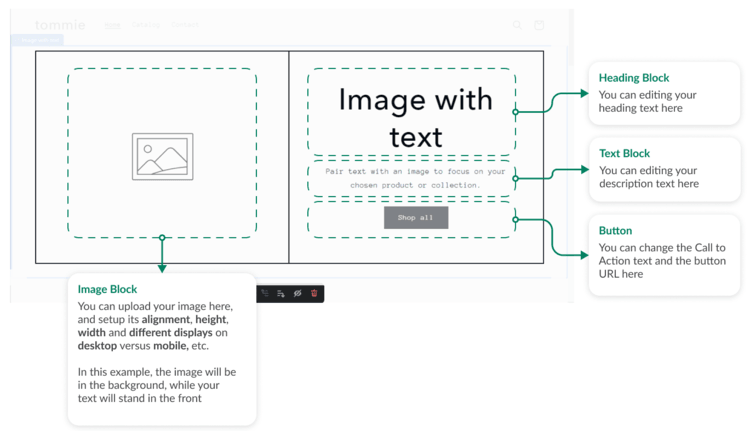
To choose a block/section to start with, click on their areas (as demonstrated above), and the right menu will change accordingly to their types of content.
Using the right menu in the theme editor, you can:
- Editing content inside sections and their blocks
- Changing blocks and section parameters: like padding, opacity, height, etc.

5 Recommended Paid Shopify Themes For Beginners
In selecting the perfect theme from our list of top single-product Shopify themes, it’s helpful to see what’s working for others. We suggest using our Shopify theme checker to uncover the themes behind successful single-product stores, enriching your decision-making process.
Eurus
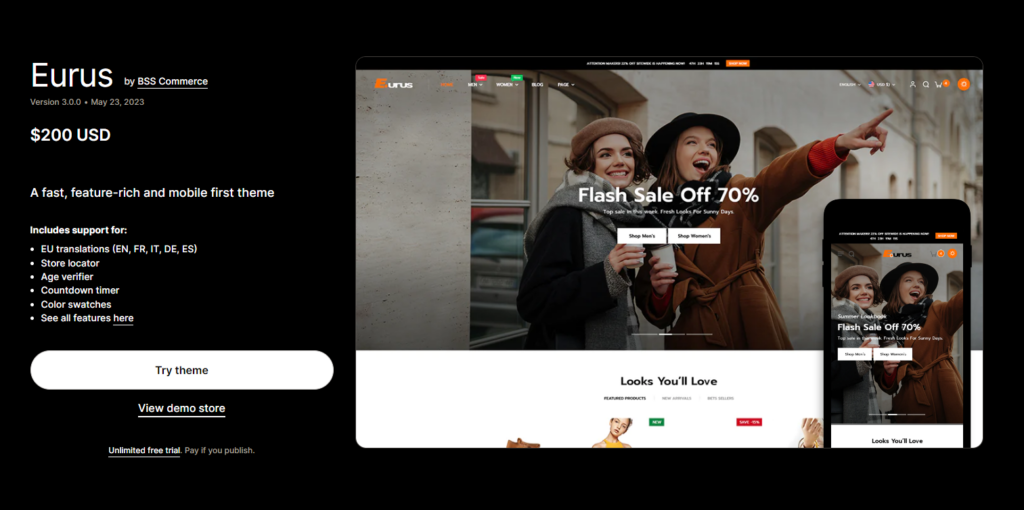
Pricing
$200
Key points
- Escape the App Clutter: This theme equips you with essential features for high conversion rates, such as a 4-level Mega menu, endless Product Badges, and per-page Pop-ups, all without the need for pricey apps.
- Fast and Mobile-Ready: Enhance sales with quicker page loading, better user experience (UX), and improved SEO. Benefit from our mobile-centric design and adaptable Light/Dark modes based on device detection.
- Tailor to Your Taste: With over 25 dynamic sections and blocks at your disposal, take full charge in crafting a visually striking store.
Venue

Pricing
$350
Key points
- Include 4 presets: Morning, Evening, Twilight, Weekend.
- Main features: events feed, sidebar filter, age checker, multiple locations, video gallery, mobile optimization, third-party delivery, color backgrounds, video sides, featured products.
- Best Shopify themes for fashion, home & garden, food & drink among 100+ best ecommerce Shopify themes 2022 collection.
Flow
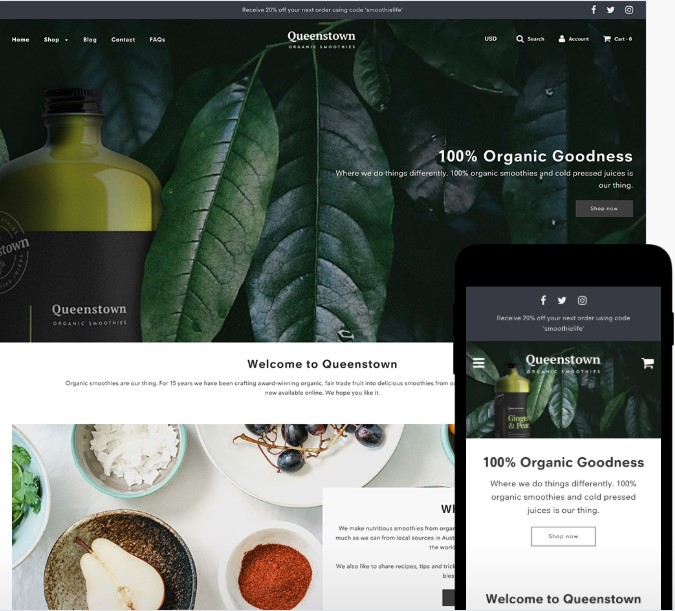
Pricing
$350
Key points
- Three presets available: Nourish, Crafted, Luxe.
- Main features: Homepage video, slide-out cart, grid-style, social media icons, collection page sidebar.
- Best ecommerce Shopify themes for clothing stores, food & drink industry, and high-volume store.
Avenue

Pricing
$280
Key points
- Three presets: Casual, Lively, Precise.
- Main features: product filter, dropdown shopping carts, slideshow, sub-collections, advanced mega menu, product hover, and quick view, endless scroll module.
- Best Shopify themes for Clothing and accessories, Food and drink, Electronic, and high-volume store.
Spark

Pricing
$320
Key points
- Three presets Chic, Clean, Minimal.
- Main features: FAQ page, infinite scroll, product filtering, store location, trust badge, slide-out cart, slideshow.
- Best Shopify themes for fashion, health & beauty, sports, and drop shippers.
Overall: What is the best Shopify theme?
What is the best Shopify theme really depends on your Industry, your Products, your business size, and the features you want to integrate into your store. Check out our best Shopify Themes ranking for each industry, including.
- Arts and crafts
- Baby and kids
- Books, music and video
- Business equipment and supplies
- Clothing
- Electronics
If you cannot find the one that fits your store, don’t be worried because the list will be gradually extended to many industries. Stay tuned!
Final words
Shopify provides both free and paid theme options. While free themes are budget-friendly, they offer limited customization and features compared to paid ones. Paid themes typically cost between $140 to $180, with some premium options reaching up to $350. Your choice between free or paid largely hinges on your store’s desired features and customization.





